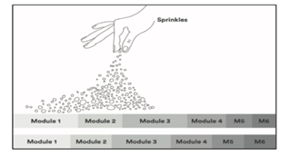Posted in: Aha! Blog > Great Minds Texas | Blog > Implementation Support Bluebonnet Learning K–5 Math > Effectively Addressing Unfinished Learning
At the start of every school year, you may wonder, “How do I adjust for missed modules and unfinished learning from last year?” The answer is to trust grade-level content and then add some sprinkles. Honestly, who doesn’t want sprinkles? With that as the guiding principle, here are some strategies to keep up with pacing while addressing unfinished learning.
Begin at the beginning. Start with Module 1.
You can’t help students catch up if you don’t teach them grade-level content. So teach your grade-level content starting with Module 1.
Every year, you must address unfinished learning to some degree, but going back and teaching long sequences of lessons from a prior grade perpetuates learning gaps. That’s because you won’t have time for that kind of intervention while you're teaching the current grade-level material.
Teach your grade-level content, and use only the specific supports your students need to access the grade-level content rather than teaching long sequences of material from earlier grades. (More on that later. )
Teach the modules in order.
The intentional design of Bluebonnet Learning K–5 Math reveals a mathematical story. Imagine picking up a great novel and reading the chapters out of order. You’d undermine the author’s storytelling, and you’d get less out of reading the book. The same thing happens for your students when you teach Bluebonnet Learning K–5 Math out of its intended order.
The first modules focus on the major work of the grade. Additionally, Bluebonnet Learning K–5 Math is intentionally designed to build mathematical knowledge in such a way that students continually deepen their learning and gain mastery over time. This means that your students need a strong start as their foundation for the year. Module 1 is that strong start, and it sets students up for success with the grade-level content. The strategic placement and coherence of all the modules are part of the beauty of Bluebonnet Learning K–5 Math. These modules give students enough practice at the right time so that students build on prior learning, make connections, and achieve mastery of key mathematical content.
You may try reordering lessons with the best intentions, but there will be unintended consequences. Since the early modules focus on the major work of the grade, moving those modules to later in the year may leave students unprepared for high-stakes tests.
To avoid these pitfalls, we strongly recommend that you start with Module 1 and honor the order of the modules. That practice provides your students with the best chance of mastering the grade-level content and being prepared for any challenges that await them.
Add sprinkles of supporting instruction just in time.

To ensure effective pacing and address unfinished learning, sprinkle instruction for unfinished learning over time, rather than clumping instruction at the beginning of the year. As you plan, you’ll discover which foundational skills students need to access the grade-level content. When students need support with those foundational skills in the course of the current module, add some sprinkles. Sprinkle in a fluency activity, a mini lesson, or some additional practice that gives students very targeted, just-in-time support. Sprinkling in a little information from time to time more fluidly integrates scaffolds and support with instructional goals and takes less time than reteaching large chunks of content up front.



.png?width=111&height=100&name=TEXAS-Phd_LOGO_58C76Y_purple_tpt%20(13).png)


.jpg?width=430&name=PhD%20Science%20(1).jpg)





.jpg?width=430&name=EurekaMath%20(1).jpg)
.jpg?width=430&name=WitWisdom%20(1).jpg)

